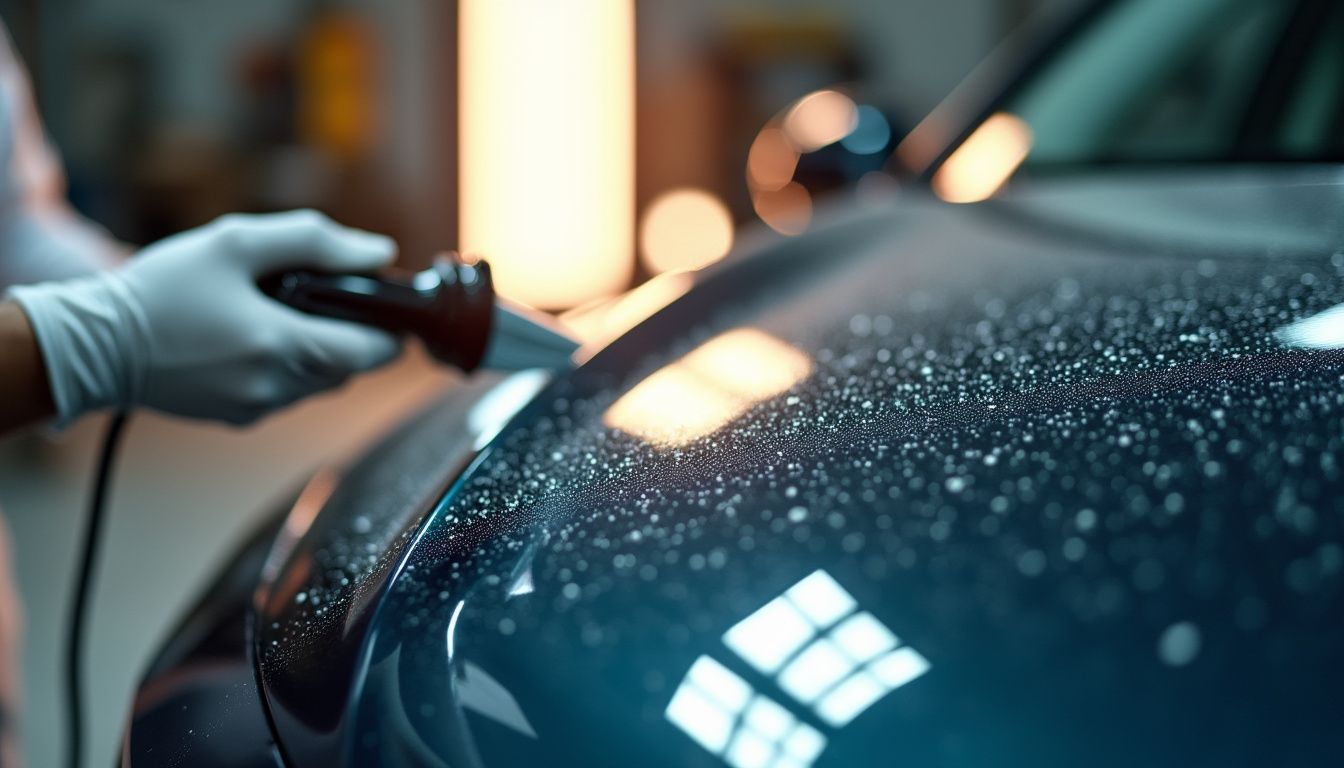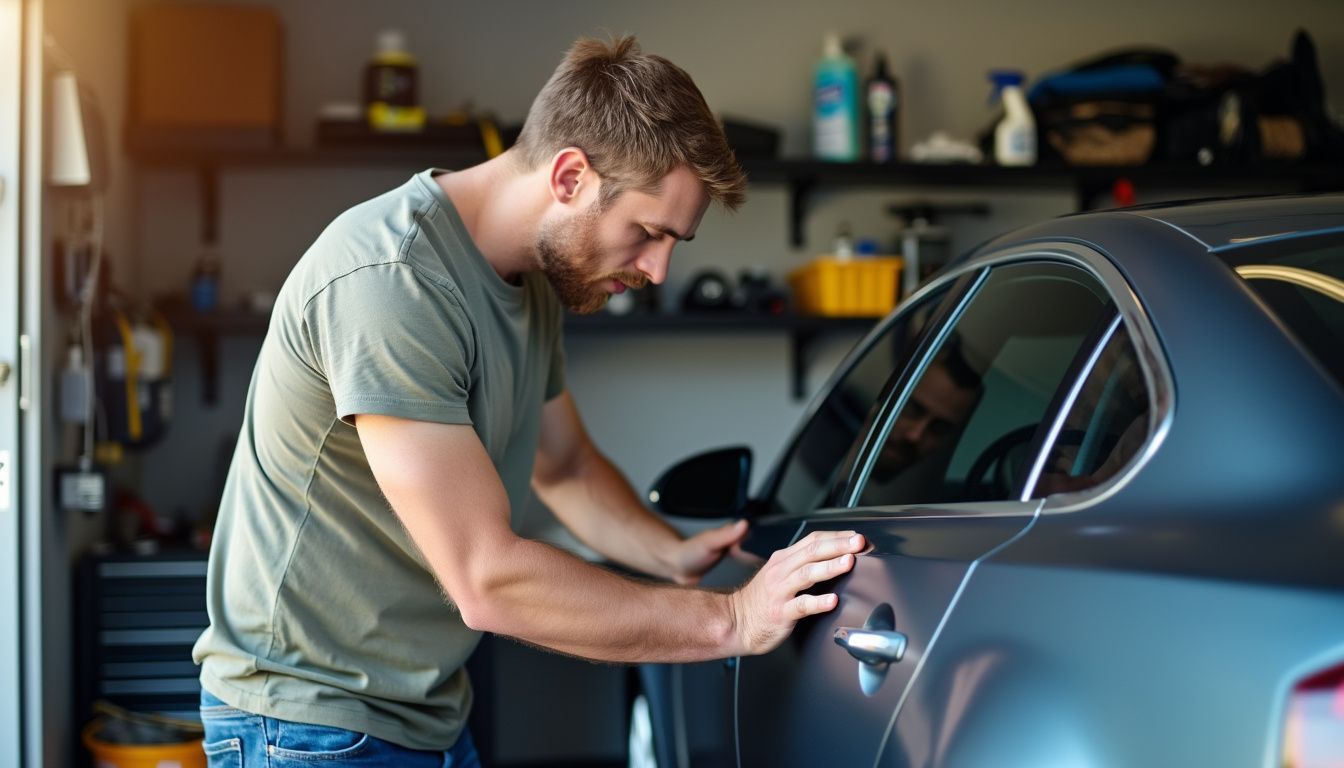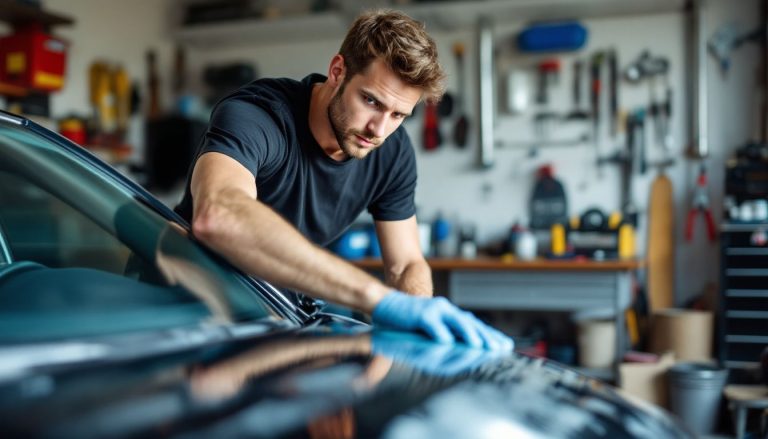Top 10 Reasons to Invest in Car Ceramic Coating for Your Vehicle
Invest in Car Ceramic Coating for Your Vehicle today!
Car ceramic coating is a tough shield for your car’s paint. It’s made from a liquid polymer, SiO2, which sticks to the paint and forms a hard layer. This layer makes your car look shiny and repels water well.
Unlike wax that you might have to apply often, ceramic coating lasts longer because it bonds with the paint on a chemical level.
This type of coating is also very thin, only 1-8 microns thick. Though it’s much thinner than Paint Protection Film (PPF), it does an excellent job protecting against things like UV rays and bird droppings that can harm your car’s paint over time.
And if you want this protection to last even longer, getting more layers added by professionals can help. For anyone who uses their car daily, choosing ceramic coating means less worry about small scratches or fading from the sun.
1 How does it work?

Car Ceramic coatings are like an invisible shield for your car. They use a liquid polymer, which is a fancy word for a type of plastic that bonds with your car’s paint. This creates a hard layer on top of the paint.
It’s so clear that you can’t see it, but it works hard to keep your car looking fresh. The main ingredient in this magic mix is SiO2, which comes from things like sand and makes the coating tough against water and dirt.
Imagine wrapping your car in glass—that’s what ceramic coating does without you even seeing it.
This special coating loves to push water away. So, when rain hits your coated car, it just beads up and rolls off. That means less dirt sticks to your car, making it easier to wash.
And we all know washing the car is not anyone’s favourite weekend job! Plus, this tough layer stays on for ages—way longer than those old-school waxes or sealants you might have tried before.
2 What are the key components of car ceramic coating?

So, we’ve seen how ceramic coating works on your car. Now let’s get into what makes it so special. The main thing in ceramic coatings is something called SiO2, or silicon dioxide, if you want the full name.
This is a form of liquid polymer that sticks really well to your car’s paint.
Once this SiO2 goes onto your car, it starts to harden. It forms a layer that’s super hard and looks like glass but don’t worry, you can’t see it at all once it’s on properly. This layer does magic for your car because water just slides right off it.
That means less dirt sticks to your vehicle making it easier to keep clean.
This hardened layer isn’t very thick – think about as thin as one or two hairs stacked up! Despite being thin, adding more layers by professional detailers can make the coating last longer.
And while some may think these layers could fix scratches or chips in the paint, they’re more about slowing down damage rather than stopping it completely.
3 Why is it different from traditional wax or sealants?

After learning about the key parts of ceramic coating, let’s talk about how it stands out from old wax or sealants. Ceramic coatings use a special liquid polymer, with SiO2 as its base.
This isn’t just any layer; it chemically bonds to your car’s paint. This bond creates a hard shield that can last from 2 to 10 years. That’s much longer than what you’d get from regular car wax.
Wax and sealants sit on the surface and wash away over time, needing more frequent applications. On top of lasting longer, ceramic coatings also offer better protection against sun rays and water marks.
Plus, they keep your car looking shiny and new for ages. Investing in a ceramic coat means less hassle with maintenance too since dirt and grime don’t stick easily to it.
How Does Car Ceramic Coating Protect Your Vehicle?

Ceramic coating acts like a shield for your car. It sticks to the paint and forms a tough, protective layer. This layer fights off water and dirt. So, your vehicle stays cleaner for longer.
Plus, cleaning it becomes a breeze because stuff just slides right off.
This coating also guards against sun damage and nasty chemicals that can stain or eat away at the paint. Unlike wax that needs redoing every so often, ceramic protection lasts years.
It’s thin but mighty, keeping your ride looking shiny without wearing down or needing constant touch-ups.
1 What types of damage can ceramic coating prevent?
So we’ve discussed the protective benefits of ceramic coating for your car. Now, let’s explore the kinds of damage it prevents. This remarkable coating has many defensive properties, akin to a superhero cape for your vehicle.
Ceramic coatings are excellent in preserving the sleek look of your vehicle. Their hydrophobic characteristic helps in repelling water effectively. This results in rain and dirt not sticking to the surface, making your car simpler to clean.
Moreover, these coatings help block UV rays that can cause paint to fade over time, and prevent chemical stains from pollutants like bird droppings and tree sap if you clean them off promptly.
Regardless, they are not impregnable barriers against everything.
While ceramic coating provides substantial protection against numerous threats, it doesn’t guarantee against all damage.
For example, washing scratches can still occur if you’re not careful or using the appropriate equipment. Regrettably, they can’t avert paint chips from stones hitting at high velocities or entirely stop fading from intense sunlight or the peeling of the clear coat over time without reapplication.
Compared to traditional waxes, it offers significantly longer duration – years rather than months – but for combatting severe scuffs and marks? You might consider Paint Protection Film (PPF) as well.
In conclusion, ceramic coatings offer significant benefits for preserving that fresh-off-the-lot look by warding off environmental pollutants and reducing the frequency and effort of cleaning sessions.
2 How effective is ceramic coating against UV rays?
Moving on from the types of damage ceramic coating can prevent, let’s talk about how it fights against UV rays. This tough layer sticks to your car’s paint, making a hard shield that stops UV rays.
These sunbeams can fade and damage your car if left unprotected. The more layers of ceramic coating you add, the better it guards against these harmful rays. Unlike wax, this super shield is much stronger in fighting off UV damage.
Ceramic coatings also reflect sunlight better than usual paints do. This means less sun damage and fading over time. However, even with this protection, it’s not a forever fix. You still need to take care of your car regularly to keep it looking great.
Regular cleaning plays a big part in keeping up the UV protection that ceramic coatings provide for your vehicle.
3 Can it protect against chemical stains and etching?

Yes, ceramic coating helps your car fight off chemical stains and etching. Things like acid rain, bird droppings, and tree sap can really damage your car’s paint. But with a ceramic coat, these nasty stuff don’t stand much of a chance.
The coating forms a shield on your car’s surface. This keeps the paint safe from those harmful substances.
Having this protection means you won’t have to wax so often. It saves you time and effort in keeping your vehicle looking great. Plus, cars with ceramic coating need less cleaning overall.
So if protecting your vehicle from environmental baddies is high on your list – investing in the best ceramic coating might just be worth it for you!
Is Ceramic Coating Worth the Investment?

Ceramic coating provides effective paint protection by forming a chemical bond with the vehicle’s paint. It creates a hard, glass-like layer that makes vehicles water-repellent and easier to clean.
Although ceramic coatings are not permanent solutions, they last significantly longer than traditional waxes, which typically last 1-6 months. However, it’s important to note that ceramic coatings do not prevent washing scratches, stone chips, or paint fade.
For comprehensive protection, Paint Protection Film (PPF) is recommended as ceramic coatings are thinner and less flexible. Traditional wax may suffice for well-maintained vehicles but highlights limitations in certain circumstances.
In conclusion, the longevity of ceramic coating and its ability to form a durable protective layer on your vehicle make it worth the investment compared to traditional waxing options.
1 What are the costs associated with ceramic coating?

Ceramic coating cost varies depending on the type and quality of the product. Typically, a professional ceramic coating service for a car could range from $500 to $2,000 or more, while DIY ceramic coating kits may start from as low as $50 and go up to hundreds of pounds.
Properly applied high-quality ceramic coatings are usually priced higher due to their longevity and effectiveness.
When getting an estimate for a professional application service, factors such as the size and condition of the vehicle can affect the overall cost. Some businesses offer different packages that include paint correction before applying the ceramic coating.
It’s important to consider this upfront investment in relation to potential long-term benefits like reduced maintenance needs and enhanced protection against environmental contaminants.
By choosing an appropriate option based on individual requirements and budget constraints, car owners can assess whether investing in a ceramic coating is worth it for their vehicle.
2 How does it compare to other protective options?
Deciding on the best way to protect your car’s paintwork is a big deal. Let’s look at how ceramic coating stacks up against other options out there. We’ve got paint protection film (PPF) and traditional waxes on the table.
| Feature | Ceramic Coating | Paint Protection Film (PPF) | Traditional Wax |
|---|---|---|---|
| Thickness | Thin (1-8 microns) | Thick (170-180 microns) | Very thin (layer dependent) |
| Protection Length | Several years | Five to ten years (but can vary) | 1-6 months |
| Resistance to Damage | Good against chemicals, UV rays | Best for impact, scratches | Minimal |
| Water Repellency | High | Medium | Low to medium |
| Shine and Gloss | Enhances significantly | Varies, can enhance | High (but short-lived) |
| Maintenance | Low | Low to medium | High |
Ceramic coatings are thinner than PPF, offering a sleek fit to your car. They last a lot longer than wax—years, in fact. They are champs at fighting off UV rays and nasty chemicals. Plus, they make your car look amazing with that extra shine and gloss.
PPF is the go-to for fending off scratches and impacts. It’s thicker and can take a hit. It does a decent job keeping your car looking good too.
Traditional wax is the old-school choice. It gives your car a nice gloss, but don’t expect it to last long or fight off much damage.
So, picking your car’s protector is all about what you value most. Want a long-lasting, glossy look with solid protection? Ceramic coating might be your match. After something to take the hits and scratches? PPF could be the way. Or, if you love the ritual of waxing your car every few months and keeping things classic, wax is still in the game.
3 What is the long-term value of investing in ceramic coating?
Investing in ceramic coating ensures long-term protection, reducing the need for frequent reapplication. The coating typically lasts 2 to 5 years or more, safeguarding the vehicle from scratches and chemical etching while maintaining a glossy finish.
Moreover, it could potentially increase your car’s resale value by up to 10%, providing financial benefits.
The hydrophobic nature of ceramic coatings also makes vehicles easier to clean, reducing washing time and effort. This ease of maintenance contributes to cost savings over time as less frequent detailing is required.
Thus, despite initial costs ranging from $500 to $3,000 for professional application, the long-term benefits make ceramic coating a worthwhile investment.
By improving resilience against damage and simplifying upkeep while potentially boosting resale value, investing in ceramic coating provides lasting advantages for your vehicle.
How Does Ceramic Coating Enhance the Appearance of Your Vehicle?
Ceramic coating creates a deep gloss on the car’s paint, enhancing its aesthetic appeal. The super hydrophobic surface repels water and dirt, making it easier to keep the vehicle clean.
This protective layer chemically bonds to the factory paint, offering a durable shield against environmental elements and maintaining the car’s appearance in top condition.
The thickness of ceramic coatings contributes to their unique protective qualities, which make them an effective option for long-lasting protection. Professional application of multiple layers can further improve the vehicle’s aesthetic and protective qualities by enhancing its overall appearance and shine while reducing maintenance requirements.
1 What aesthetic benefits does ceramic coating offer?
Ceramic coating establishes a durable, glass-like protective layer that amplifies the shine and depth of your car’s paint. This creates a surface that effectively repels water and dirt, simplifying the cleaning process.
Furthermore, it shields against UV rays, chemical stains, and etching to preserve your car’s appearance. The coating also augments reflective properties for a richer and more vibrant look while bolstering durability with each layer applied.
Essentially, ceramic coating enhances not only the visual appeal of your vehicle by imparting a polished look but also ensures that this aesthetic endures. Ceramic coatings offer superior protection in contrast to traditional wax against environmental factors such as oxidation, ensuring long-lasting lustre.
Therefore, investing in ceramic coating means upholding your vehicle’s pristine appearance for an extended period.
Moving on to “4.2 How does it improve shine and gloss?”.
2 How does it improve shine and gloss?
Transitioning from the aesthetic benefits of ceramic coating, it’s crucial to comprehend how this treatment elevates shine and gloss. Ceramic coating enhances the reflective properties of your vehicle’s clear coat, delivering a deeper gloss that retains its shine for a prolonged duration.
This protective layer establishes a glass-like finish by binding chemically with the factory paint, bolstering durability and conserving the car’s appearance.
By chemically binding with the factory paint, ceramic coating presents heightened hydrophobic properties, meaning it effectively repels water and dirt compared to conventional wax or sealants.
This not only guarantees simpler cleaning but also shields the car from damage caused by environmental factors. The application of professional-grade products like Mothers CMX Ceramic Spray and Meguiar’s Hybrid Ceramic Wax further amplifies gloss while furnishing enduring protection against UV rays – a pivotal element in preserving the pristine look of your cherished possession.
3 Can it help maintain your car’s resale value?
Ceramic coating can assist in preserving your car’s resale value. It shields the paint from UV rays, preventing fading and oxidation, resulting in a prolonged vibrant and glossy appearance.
This improved look enhances your car’s appeal to prospective buyers, ultimately increasing its resale value.
The hydrophobic nature of ceramic coatings establishes a shield that repels dirt, water, and grime. This simplifies the car cleaning process and sustains its polished appearance, offering an extra selling feature when the time comes to sell or trade your vehicle.
Ultimately, investing in ceramic coating not only safeguards your car’s exterior but also helps in maintaining its value in the competitive used-car market.
By employing high-quality products to maintain a ceramic-coated vehicle, this protective shield can endure for several years, demonstrating its lasting influence on preserving your car’s resale value.
Therefore, taking into account all these considerations assists in maintaining your vehicle’s exterior in optimal condition, which positively impacts its worth at the time of resale.
How Easy is it to Maintain a Vehicle with Ceramic Coating?
Maintaining a vehicle with ceramic coating is simple and requires minimal effort. The hydrophobic nature of the coating makes cleaning easy as dirt and water slide off effortlessly.
Regular maintenance such as washing is still necessary, but it’s easier due to the protective properties of the ceramic coating. While scratches or etchings from contaminants aren’t entirely prevented, the longevity of the coating can be enhanced through professional application and proper care.
Ceramic coatings do not last indefinitely; ongoing attention is essential to address issues like paint fade and clear coat peeling. Despite this, they offer increased durability along with enhanced reflective properties resulting in a deeper gloss that requires less frequent polishing.
When properly maintained, ceramic coatings can provide long-lasting protection for your vehicle with ease.
1 What maintenance does a ceramic-coated vehicle require?
Maintaining a ceramic-coated vehicle involves:
- Regularly washing the car with pH-balanced soaps to avoid damaging the coating.
- Promptly cleaning contaminants like bird droppings and tree sap to prevent etching.
- Being mindful of washing scratches, swirls, and minor blemishes that can still affect the coating’s protection.
- Applying more layers of ceramic coating to enhance durability and protection.
- Understanding that environmental conditions and owner care influence the longevity of the ceramic coatings.
2 Is it easier to clean a ceramic-coated car?
Ceramic coating makes cleaning your car easier because the surface repels water and dirt. This means less effort is needed to remove contaminants, making maintenance a breeze. Compared to traditional wax finishes, ceramic-coated cars require less upkeep.
Regular washing becomes simpler due to the smooth finish provided by the coating.
An additional benefit of ceramic coating is its ability to reduce the time and energy required for maintaining your vehicle’s cleanliness. Dirt and grime are easily removed from a ceramic-coated surface, resulting in a more straightforward and streamlined cleaning process – saving you time and hassle in the long run.
3 How does it reduce the frequency of detailing?
Transitioning from the ease of cleaning a ceramic-coated car, let’s discuss how it reduces detailing frequency. Ceramic coating forms a tough layer that protects the vehicle’s paint.
This means less dirt and grime cling to the surface, making it simpler to clean. The hydrophobic properties repel water and prevent contaminants from sticking, reducing the need for frequent washing and detailing.
With proper maintenance, a single application can last several years, cutting down on regular waxing and detailing sessions.
Moreover, ceramic coatings require only quick washes due to their ability to repel dirt and grime accumulation. They also minimise harsh chemical usage during cleaning, contributing to environmental friendliness by reducing water consumption and pollutants from chemicals without sacrificing protection for your vehicle’s exterior.
What Are the Environmental Benefits of Ceramic Coating?
Reducing frequent repainting cuts down environmental waste. The coating’s hydrophobic properties minimise harsh chemical and water use for cleaning, benefitting the environment. It also enhances paint longevity, reducing the environmental impact from manufacturing new paint.
Less frequent washing decreases water runoff and pollution, which is helpful to ecosystems.
The protective layer provided by ceramic coatings prevents UV damage and oxidation, extending vehicle lifespan and reducing premature disposal. Moreover, because of this protection increased requirement for waxing is minimised which leads to less waste from containers and products.
In essence, ceramic coating promotes sustainable vehicle care by requiring fewer resources for maintenance.
In conclusion while creating the content in an engaging way include entities such as “environmental benefits”, “ceramic coatings”, “hydrophobic properties”, “sustainable vehicle care” are used appropriately.
1 How does it contribute to eco-friendliness?
Ceramic coating plays a significant role in promoting eco-friendliness. It lessens the necessity for frequent car washes, thereby conserving water and cleaning materials. Lasting for several years, it minimises waste in comparison to traditional waxes.
This, in turn, sustains a vehicle’s appearance for a longer period, potentially extending its lifespan and reducing the need for repainting. With its hydrophobic properties, it necessitates the use of milder cleaning chemicals, offering protection against UV rays and chemical stains whilst preserving the paint and finish.
Moreover, by improving reflective properties that lessen heat absorption, ceramic coating enhances energy efficiency, thereby reducing the requirement for excessive maintenance products and encouraging sustainable car care.
These advantages of ceramic coating align with an environmentally conscious approach to vehicle protection, aiming to minimise resource usage and waste production.
2 Can it reduce the need for harsh cleaning chemicals?
Now, let’s see if ceramic coating can help reduce the use of strong cleaning chemicals. Ceramic coatings create a super hydrophobic (repelling water) surface on vehicles. This feature makes cleaning easier as water and dirt are repelled off the coated surface.
Because contaminants are easily removed from coated surfaces, it reduces the need for heavy-duty cleaning and harsh cleaning chemicals. The durable nature of ceramic coatings also means less frequent use of cleaning products.
In summary, the hydrophobic properties of ceramic coatings make it easier to clean your car, resulting in reduced dependence on harsh cleaning chemicals.
3 Does it help in reducing the overall carbon footprint?
Ceramic coating can enhance the overall carbon footprint by promoting eco-friendly car care. It reduces water usage due to its hydrophobic properties, minimising the need for harsh chemical cleaners and decreasing chemical waste.
The durability of ceramic coatings also reduces waste from frequent reapplications of traditional waxes and sealants while safeguarding a vehicle’s exterior, resulting in decreased demand for new vehicle purchases.
This decrease in new vehicle demand results in fewer carbon emissions associated with manufacturing and transporting cars.
The environmental benefits are further enhanced as vehicles with ceramic coatings only need water and mild soap for cleaning, which minimises the use of aggressive cleaners, conserves water through less frequent washes, and decreases the usage of harmful cleaning chemicals.
Additionally, preserving a vehicle’s exterior leads to less frequent repainting or refinishing, contributing further to the reduction in environmental impact. In total, ceramic coating offers significant advantages in lessening the carbon footprint within the world of car maintenance.
Who Should Consider Investing in Ceramic Coating?
Vehicle owners who want to protect their car’s appearance, especially those concerned about environmental pollutants or interested in maintaining a glossy finish. Car enthusiasts and individuals looking to simplify vehicle maintenance would also benefit.
Notably, people conscious of resale value and environmental impact should consider ceramic coating as it reduces water usage and chemical impact.
FAQs
1. Why should I invest in ceramic coating for my car?
Ceramic coating is a “must-have” for many car owners because it provides long-lasting protection to the surface of your car. It’s designed to keep your vehicle looking brand new, which can be especially beneficial if you’re thinking about selling your car down the line.
2. How does ceramic coating protect my vehicle?
The properties of ceramic coating make it easier to wash off dirt and grime without damaging the paintwork or causing swirl marks. Plus, a properly applied ceramic coating bonds with your paint, forming a protective layer that helps prevent damage from UV rays and other environmental factors.
3. Is the cost of ceramic coatings worth the investment?
While the upfront cost may be higher than traditional wax or sealant products, many car owners find that high-quality ceramic coatings are undoubtedly worth it! They last longer and require less maintenance than most alternatives, saving you time and money in the long run.
4. Can I still use automatic or touchless car washes with a coated vehicle?
You sure can! However, hand washing using a pH-neutral car wash is recommended as harsh chemicals found in some automatic washes could potentially damage the coating over time.
5. What kind of upkeep does a ceramic coated car require?
Despite what some might think – having your ride coated doesn’t mean you never have to clean it again! Regular washing will keep your “ceramic chariot” looking its best… but remember not all soaps are created equal; stick with those friendly pH-neutral ones!
6. Are there different types of ceramic coatings available?
Absolutely mate! There’s quite an array on offer – from 9H optically clear ceramics that offer top-notch shine and protection to more affordable options that still provide great value for money.




